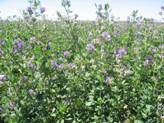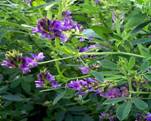AGR 301 :: Lecture 19 :: LUCERNE Medicago sativa)
![]()
Lucerne (Medicago sativa) is a perennial leguminous fodder crop for unirrigated areas including low, mid and high hills of the State. It has a good vegetative growth almost throughout the year except during heavy rains or when the temperature is near or below freezing point. It enriches and rejuvenates the exhausted soils.
- Season & varieties
- Thru’ year , CO 1
- Not suitable for very hot and cold climate
- Varieties
Sirsa-9 (Type-9): It is the recommended variety of lucerne. It is a quick growing variety attaining plant height of about one meter at early flowering stage. It has green foliage, slender stalks and purple coloured flowers. It gives, on an average, 400-600 qunitals green fodder and 80-120 qunitals dry matter yield per hectare per year in about four cuttings. It contains, on an average, 22 per cent crude protein on dry matter basis.
Anand-3 : It has dark green trifoliate leaves, medium thick stem, deep root system, tillers vary from 10-15/plant, flowers are blue in colour and have quick regeneration capacity. On an average, it provides 400-500 q/ha of green fodder in 5-6 cuttings annually. Its herbage contains 23-24% CP(DM) and is very nutritive.
- Field preparation
- Apply 12.5 t FYM
- Beds & channels 10- 20m
- Soil
Deep and well drained loamy soils are best for this crop. It is very susceptible to acidic soil, therefore, it cannot be grown in soil with pH below 6.5 unless lime is applied. Liming should be done after getting soil samples analyzed for pH one month before seeding.
- Sowing time
Best time of sowing is the first fortnight of October to end of November.
- Seed rate and method of sowing
Seeding should be done in rows 40 cm apart at a seed rate of 15 kg per hectare. Because of their hard seed coat, seed should be soaked overnight in water before seeding. Like berseem, it must be inoculated with rhizobium culture, if the seeding is going to be done for the first time in any field.
- Seed rate
- 20 kg /ha of cuscuta free seeds
- Spacing
- 25cm with solid row
- Irrigation
First irrigation should be applied about a month after sowing. The subsequent irrigations may be given at an interval of 15-30 days depending upon weather conditions. During rainy season, water should not be allowed to stagnate.
- Fertilizer
- 25-120-40 NPK
- Harvest
- First cut at 75-80 DAS, subsequent cut at 25-30 days
- Green fodder
- 70-80 t in 10 cuttings
- Yield
The newly grown crop is usually ready for first cutting in about 2-4 months after the seeding depending upon the altitude. The subsequent cuttings may be taken at intervals of 30 to 40 days. If may give, on an average, 350 quintals green fodder per hectare per year.
- Seed production
The lucerne crop, which has not been cut for fodder, gives best seed yield. No cutting should be taken later than January from established crop if it is to be kept for seed purposes. On average, 0.5 qunitals seed is obtained per hectare.


Lucerne (Irrigated perennial)
1. |
Season & Soil |
Throughout year, Loamy soil |
2. |
Field Preparation |
1 Iron Plough + 2 Country plough |
3. |
Manuring |
Basal : FYM/Compost : 25t/ha, 25:120:40 kg NPK |
4. |
Seeds & Sowing |
20 kg/ha (Rs.400/kg), 25 cm x Solid sowing, Rhizobium 3 pocket, 2 cm depth |
5. |
After |
Weeding & gap filling 20th Day, Earthing up after 3 cuts, Cuscuta : Good seed, Remove & burn with host, Avoid sowing for 3 yrs. |
6. |
Irrigation |
After sowing, Life irrigation, 7 days interval |
7. |
Protection |
Aphide: Malathion 4-5 DAH |
8. |
Harvest |
Ist : 75 – 90 DAS, 25 – 30 Days (10 – 15% flower) |
9. |
Yield |
80 – 100 t/ha (12-13 cut) - GFY |
Multiple choice questions
- Soil suitable for Lucerne cultivation is ________
a. Loamy soil b. Clay soil c. Heavy soil - The centre of origin of Lucerne is __________
a. S. Africa b. America c. S.W.Asia - One of the oldest cultivated fodder crop is ________
a. Guinea grassb. BN grass c. Lucerne - Ideal time of sowing of Lucerne is ____
a. Oct.-Nov. b. May - June c. Jan. – Feb. - Parasitic weed found in Lucerne is ________
a. Orobanche b. Cuscuta c. Striga
| Download this lecture as PDF here |
![]()